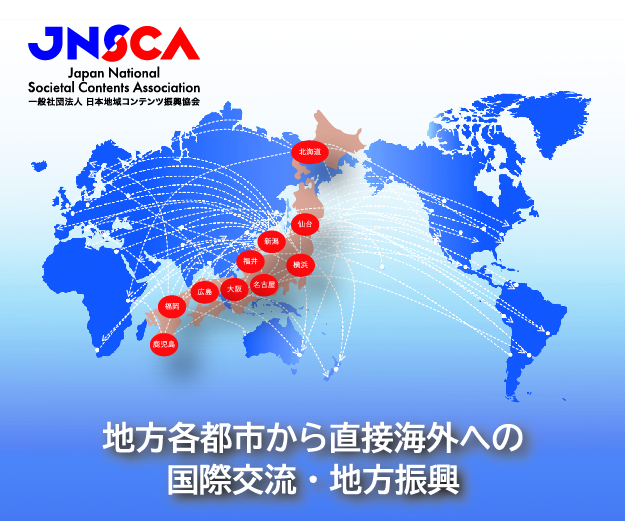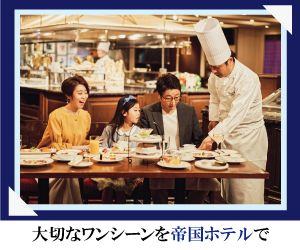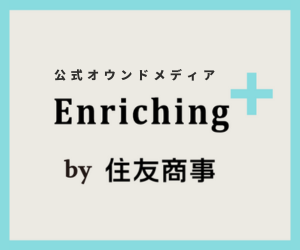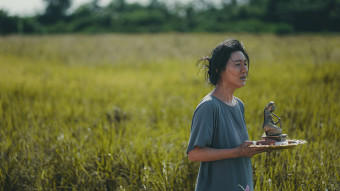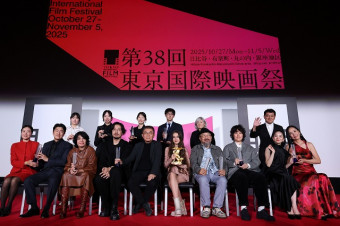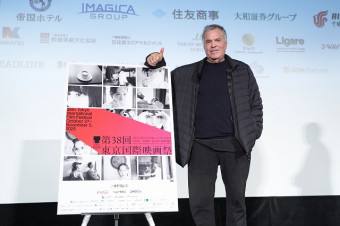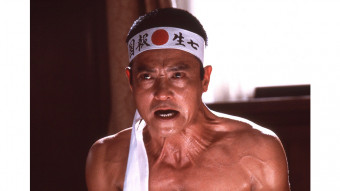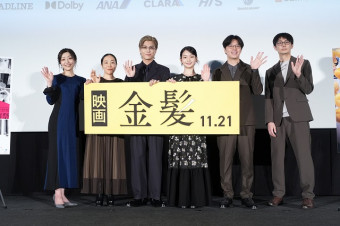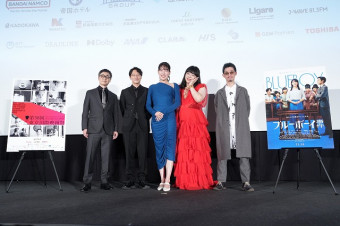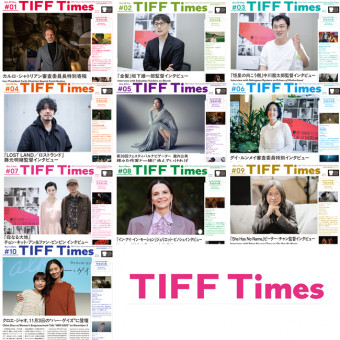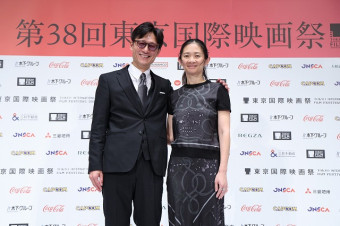A press conference highlighting the 38th Tokyo International Film Festival (TIFF)’s Animation Section was held at the Foreign Correspondents’ Club of Japan (FCCJ) on October 9, followed by a sneak preview screening of award-winning director Kinoshita Baku’s feature-length animated debut, The Last Blossom, in an exclusive English-subtitled presentation.

Ichiyama Shozo, Programming Director of the 38th TIFF, opened the session by discussing the festival’s highlights, noting the predominance of films from Southeast Asia this year, as well as the number of films about actual historical figures.
Before introducing TIFF Animation Section Programming Advisor Fujitsu Ryota, the moderator reminded the audience that animation is not only a beloved and versatile art form, but also a significant cultural export for Japan and increasingly important economic engine for the country. Fujitsu then shared insights into this year’s lineup and related panels—including a special 80th anniversary symposium related to the end of WWII—and discussed his selection of Kinoshita Baku’s The Last Blossom. Fujitsu, who has been with TIFF since the Animation Section was founded in 2019, commended the young director for his film’s unique story as well as storytelling style that is less kinetic than that of many of his peers.
Kinoshita Baku discussed the impetus for his unusual story, as well as his wide-ranging influences, from Takahata Isao and Miyazaki Hayao, to Martin Scorsese, Quentin Tarantino and Kitano Takeshi.
The 38th TIFF will be held from October 27 to November 5, 2025 in the Hibiya-Yurakucho-Marunouchi-Ginza area and at other venues in Tokyo.
Quotes from the Press Conference
– Ichiyama Shozo, 38th TIFF Programming Director
I think that we have another very strong year for the selection. Whereas last year we had quite a few films from China, we have more films from Southeast Asia this year. In the Competition section, there are three films from Southeast Asia—one from Cambodia, one from Thailand and one from Malaysia. In the World Focus section, we have one Vietnamese film, one from Singapore, and one from the Philippines. We have a very strong selection from Southeast Asia, but we didn’t do this on purpose, we just found so many good dramas from the region. This probably reflects the situation the film industry in those countries are doing better. There are a lot of films being made and many local investors, many local companies that are investing in the local films.
Another point about the lineup is that there are several films that are based on actual historical figures. In the main Competition, we have Mother from North Macedonia, about the early days of the Mother Teresa. In the World Focus section, we have The Captive, by Alejandro Aménabar, which is based on the young Cervantes. The Philippine film Magellan is based on a historical person and stars Gael Garcia Bernal. The Closing Film, Chloé Zhao’s Hamnet, tells the story of Shakespeare’s wife and of course, Shakespeare also appears in the film, played by Paul Mescal. And finally, this year is the 100th anniversary of Mishima Yukio, and we will show two Japanese classic films that are based on Mishima novels, one documentary in which Mishima appears, and Paul Schrader’s Mishima: A Life in Four Chapters, which was made in 1985. The film was not released in Japan for reasons that are unclear, but it did very well in many other countries and won the Best Artistic Contribution Award at the Cannes Film Festival. The film has been restored in 4K, so it will be very special to watch it on a big screen at TIFF. I think today’s filmmakers are thinking deeply about history, and depicting real incidents or historical events that show a different story from what we’ve seen before, while reflecting the present situation in the world.
– Fujitsu Ryota, 38th TIFF Animation Section Programming Advisor
Just to give you a brief overview of what we will be showing this year in TIFF’s Animation Section, I think we can split the selection into three broad brackets: six of the films are domestic titles, which could probably be categorized as “pushing expressive boundaries,” while the five international titles focus on “the relationship between the world and the self.” In addition, we have a retrospective program that will feature Momotarō – Sacred Sailors (1945), a Pacific War–themed film, marking 80 years since the end of the Second World War. And we will also be hosting three seminars, including one that is focused on the anniversary of the war’s end.
The Last Blossom, directed by Mr. Kinoshita, was chosen both for its unique storytelling approach and its continuity with Japanese animation traditions. Unlike the majority of Japanese animated works, which typically center on adolescent protagonists and are quite kinetic in style, The Last Blossom features an elderly yakuza man as the protagonist. This unusual narrative perspective immediately sets the work apart. At the same time, Mr. Kinoshita inherits a lineage in Japanese animation that traces back to Takahata Isao’s pioneering efforts half a century ago: the meticulous depiction of everyday life as a means of expressing human presence and emotion. This stylistic approach remains a vital element in contemporary Japanese animation.
So first and foremost, The Last Blossom is a very unique film. Mr. Kinoshita’s career path has been equally distinctive. He began as a character designer and animator, rather than as a director-creator. Between his previous work and The Last Blossom, he deliberately returned to the production floor at studio Clap, working as an animator to re-immerse himself in studio animation workflows. This was not merely a technical exercise in drawing; it was a conscious opportunity to re-examine the collaborative production process and understand how different elements combine to build effective on-screen sequences.
Q&A session with Kinoshita Baku, Director/Character Designer (after the screening of The Last Blossom)
Q: This is such a beautiful, poignant film, which feels almost like a new genre: animation for adults. Can you tell us a little about the genesis of this unusual story?
Kinoshita: The Last Blossom was in production for about 2 1/2 years. As Mr. Fujitsu mentioned earlier, our goal from the outset was to create the film with great care and attention to detail. So now that it’s finished, hearing people describe it as “beautiful” or “carefully crafted” makes me genuinely happy. Thank you.
I’d vaguely wanted to create a story with an object that talks. My previous film featured animals, so this time I decided to choose something non-animal. The scriptwriter, Konomoto Kazuya, thinks I am particularly skilled at advancing a story through dialogue, so we decided to place a talking object at the core of the narrative — and that became the flower.
Q: Why did you decide the talking flower should be a hosenka (balsam flower) rather than something a little more showy or representative of Japan?
Kinoshita: I decided on hosenka right from the initial planning stage. When I was looking for a motif among plants, I realized that different flowers each have their own survival and reproduction strategies. The hosenka also has a particularly interesting feature: when touched, its seed pods burst open and scatter the seeds. I found this dynamic external movement fascinating, which is why I chose the balsam flower as the motif.
Q: We see fireworks several times in the film and they are just gorgeous. They seem to have a symbolic meaning. What do the fireworks symbolize?
Kinoshita: The keyword that guided the entire film was “bursting/exploding/popping.” Working backwards from that, we selected motifs such as bubbles, balloons, hearts, and fireworks—all things that burst. Fireworks in particular embody this idea most vividly. They also mirror Akutsu’s [the protagonist’s] life: they flare brightly for a moment, display their beauty, and then disappear. Fireworks serve as a motif for something that shines beautifully for an instant before scattering. They’re ephemeral and fleeting.
Q: You’ve taken an unusually understated, quiet approach to storytelling that is atypical of animation. What do you think animation brings to the story that live-action wouldn’t?
Kinoshita: Being given the opportunity to create an original work is extremely rare, so I approached it with a strong sense of challenge. Fundamentally, I wanted to create something that did not yet exist. In recent years, much of animation has been very dynamic—which is exciting, and I don’t mean this as a criticism—but I believe that emotions and storytelling can also be conveyed through stillness, composition and lighting. This is the kind of expression I wanted to pursue, and that became the challenge I set for this film.
These days, it’s become so easy for anyone to capture gorgeous images on film. But I wanted to create something fundamentally beautiful such as the blue sky and the sunlight filtering through the leaves, and I felt that doing so in hand-drawn 2D animation allowed us to bring another level of beauty to every frame, which simply couldn’t be captured in live action.
Q: Who are your influences from the world of film?
Kinoshita: There are many directors who have influenced me. Of course, Takahata Isao and Miyazaki Hayao have had a huge impact. I’ve also been influenced by live-action filmmakers such as Martin Scorsese, Quentin Tarantino, and Kitano Takeshi. I’ve always been interested in works that depict human beings, and that’s where many of my strongest influences lie. I believe that the essence of cinema is to portray human change, and that’s something I place great importance on in my own work.
Q: Your film had its world premiere at Annecy International Animation Film Festival and you’re now taking it to TIFF. From a global perspective, what kind of animation creator do you aspire to be, and what do you aim to achieve as part of the next generation?
Kinoshita: I believe that animation is a wonderful cultural form that transcends national borders. Japanese animation is incredibly popular overseas, but I place great importance on creating works that are deeply rooted in Japanese culture and locality, while maintaining artistic integrity and pursuing innovation. I want to develop animation that draws inspiration from Japan’s cultural and traditional foundations, while also creating something new.
Guest profile
Kinoshita Baku
Animation director, character designer and illustrator. Kinoshita has been active since studying at Tama Art University. After joining video production company P.I.C.S., he worked as an animator and assistant director on commercials and music videos. In 2021, he made his directorial debut and handled character design for the TV anime Odd Taxi which earned him a Crunchyroll Anime Award for Best Director, among other international honors. The Last Blossom marks his feature debut and had its world premiere in competition at the 2025 Annecy International Animation Festival.
The Last Blossom
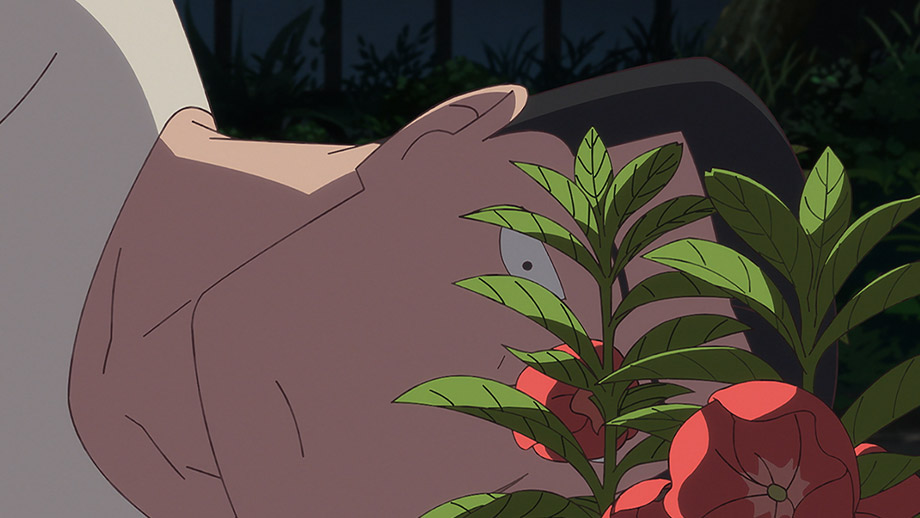
There’s nothing more hopeful than a story about second chances, and Kinoshita Baku’s singular debut feature, The Last Blossom, deploys deceptively simple, color-soaked 2D animation to take audiences on an unusual and moving journey of redemption — with a housenka (garden balsam) as their guide.
Official Selection for the Feature Film Competition, Annecy International Animation Film Festival 2025. The creators of Odd Taxi, Kinoshita Baku and Konomoto Kazuya, join forces with Studio CLAP (Pompo: The Cinéphile) to deliver a bold new feature capturing worldwide attention, releasing in Japan on October 10.
Directed by: Kinoshita Baku
Written by: Konomoto Kazuya
Produced by: Kambe Maki, Ito Hirofumi, Ueda Tomoki
Animation Producers: Matsuo Ryoichiro, Ito Kinue
Voice cast: Kobayashi Kaoru, Tozuka Junki, Mitsushima Hikari, Miyazaki Yoshiko, Pierre Taki
Official Website: anime-housenka.com (in Japanese)













